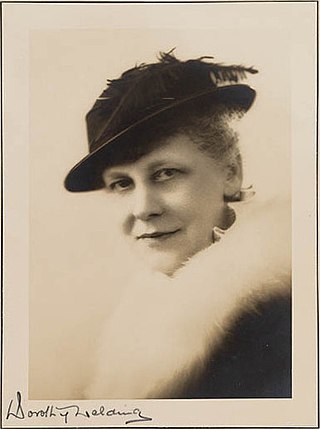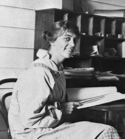Related Research Articles

Walter Burley Griffin was an American architect and landscape architect. He designed Canberra, Australia's capital city, the New South Wales towns of Griffith and Leeton, and the Sydney suburb of Castlecrag.

Marion Mahony Griffin was an American architect and artist. She was one of the first licensed female architects in the world, and is considered an original member of the Prairie School. Her work in the United States developed and expanded the American Prairie School, and her work in India and Australia reflected Prairie School ideals of indigenous landscape and materials in the newly formed democracies. The scholar Debora Wood stated that Griffin "did the drawings people think of when they think of Frank Lloyd Wright ." According to architecture critic, Reyner Banham, Griffin was "America’s first woman architect who needed no apology in a world of men."

Architecture of Australia has generally been consistent with architectural trends in the wider Western world, with some special adaptations to compensate for distinctive Australian climatic and cultural factors. Indigenous Australians produced a wide range of structures and places prior to colonisation. Contemporary Indigenous practitioners are active in a broad range of built environment fields. During Australia's early Western history, it was a collection of British colonies in which architectural styles were strongly influenced by British designs. However, the unique climate of Australia necessitated adaptations, and 20th-century trends reflected the increasing influence of American urban designs and a diversification of the cultural tastes and requirements of an increasingly multicultural Australian society.

The Australian Institute of Architects, officially the Royal Australian Institute of Architects, is Australia's professional body for architects. Its members use the post-nominals FRAIA (Fellow) and RAIA. The Institute supports 14,000 members across Australia, including 550 Australian members who are based in architectural roles across 40 countries outside Australia. SONA is the national student-membership body of the Australian Institute of Architects. EmAGN represents architectural professionals within 15 years of graduation, as part of the Australian Institute of Architects.

Florence Mary Taylor was the first qualified female architect in Australia. She was also the first woman in Australia to fly in a heavier-than-air craft in 1909 and the first female member of the UK's Institution of Structural Engineers in 1926. However, she is best known for her role as publisher, editor and writer for the influential building industry trade journals established in 1907 with her husband George, which she ran and expanded after his death in 1928 until her retirement in 1961.
North Arm Cove is a suburb of the Mid-Coast Council local government area in the center of the Hunter and the southern extremity of the Mid North Coast regions of New South Wales, Australia. It is located adjacent to Port Stephens and extends well north of the Pacific Highway. The suburb is sparsely populated, with most of the residents living in the southern portion of the suburb.
Dona Enfreeda Rangani Chitra Weddikkara (1947), known as Chitra Weddikkara, is a Sri Lankan professor of building economics, a chartered architect, a chartered quantity surveyor, an external examiner, an administrator, and a frequent speaker at construction-related professional venues.

Women in architecture have been documented for many centuries, as professional practitioners, educators and clients. Since architecture became organized as a profession in 1857, the number of women in architecture has been low. At the end of the 19th century, starting in Finland, certain schools of architecture in Europe began to admit women to their programmes of study. In 1980 M. Rosaria Piomelli, born in Italy, became the first woman to hold a deanship of any school of architecture in the United States, as Dean of the City College of New York School of Architecture. In recent years, women have begun to achieve wider recognition within the profession, however, the percentage receiving awards for their work remains low. As of 2023, 11.5% of Pritzker Prize Laureates have been female.
Justin Bere is a British architect based in London. He is founder of his own practice bere:architects and has developed a specialism in low energy passive house (Passivhaus) buildings, resulting in the first certified passive house building in London in 2010. In 2012 he was named one of the most influential people in UK sustainability by Building Design magazine.
Professor Virginia Louise Cox is an Australian architect who has made a significant and distinguished contribution 'to architecture as a practitioner, through executive roles with international professional organisations, and to architectural education and heritage conservation'.
Helen Marian Lochhead is an Australian architect and urbanist who combines academic and expert advisory roles with practice. Her career has focused on the inception, planning, design, and delivery of complex urban projects ranging from city improvements programs to major urban regeneration projects. She has held numerous influential roles in government, industry and universities including Dean, Faculty of Built Environment and Pro Vice-Chancellor Precincts at UNSW Sydney, National President of the Australian Institute of Architects and Deputy Government Architect in NSW. She has served on various Panels and Boards including the NSW Independent Planning Commission, The Australian Heritage Council and the National Capital Authority.
Jennifer Evelyn Taylor was an Australian architect, professor, critic and author who made a significant contribution to writing on contemporary Australian, Japanese and South Pacific architecture.

Beatrice May Hutton was an Australian architect. On 30 October 1916, she became the first female to be accepted into an institute of architects in Australia. This followed the rejection of earlier female applicants, including Florence Taylor in 1907, on the grounds of being female.
Abbie Galvin is the 24th NSW Government Architect. Formerly a Principal of Australian architecture, urban design and interior design practice BVN Architecture. She is a registered Architect in NSW, Victoria, ACT and SA and is also a member of the Australian Architecture Association.
Dimity Reed is an architect, urbanist and academic. She has been involved in government advisory roles, as well as writing for both The Sun and The Age newspapers.
Penelope Alice Marjorie Seidler AM is an Australian architect, former member of National Gallery of Australia Council, and current member of the NGA Foundation Board. She is also an accountant and director of the Sydney-based architectural firm Harry Seidler and associates. She was the wife and professional partner of architect Harry Seidler. She was the subject of the 2014 Archibald prize winning portrait by Fiona Lowry.
Beverley Garlick is an Australian architect.
Rachel Neeson is an Australian architect and lecturer in architecture. Her architecture practice Neeson Murcutt Architects, formed with her late partner Nick Murcutt in 2004, was awarded the Australian Institute of Architects Robin Boyd Award for Residential Architecture – Houses (New) in 2011.
Buhrich House II is a heritage-listed residence located at 375 Edinburgh Road, Castlecrag, City of Willoughby, New South Wales, Australia. It was designed by Hugh Buhrich and built during 1972. The property is privately owned by members of the Buhrich family. It was added to the New South Wales State Heritage Register on 25 May 2001.
Oi Choong is an Australian landscape architect and urban designer, and a Fellow of the Australian Institute of Landscape Architects.
References
- ↑ "LinkedIn".
- ↑ "Australian Women's Register". Trove. National Library of Australia.
- 1 2 3 4 "BPN Sustainability Judges Announced for 2014". Architecture and Design.
- ↑ "Our Ambassadors". 1 Million Women.
- ↑ Farelly, Elizabeth (24 August 2002). "Anything but the kitchen sink". The Sydney Morning Herald.
- ↑ "Congratulations to the 2014 Living Building Challenge Heroes". Living Futures Institute Australia. Living Futures Institute.
- ↑ Powell, Rose (3 February 2013). "Five women set to disrupt their industries".
- Cheng, Linda, Caroline Pidcock, Ken Maher, Belinda Allwood, Ellen Buttrose, Paul Toyne, Jefa Greenaway, et al. “A Sustainable Future Starts Now : Architects Are, to Varying Degrees, Changing Their Processes and Priorities to Create More Sustainable Designs. But It Can Be Difficult to Get Clients and Others on Board. Here, Members of the Profession Explain How They Are Approaching This Issue and Discuss the Best Ways to Move the Industry Forward.” Architecture Australia 109, no. 3 (May 1, 2020): 58–63.
- Lahoud, Adrian. “Parasite and Machine [Shellharbour Workers’ Club].” Architecture Australia 93, no. 2 (March 1, 2004): 38–39.
- Pidcock, Caroline. “Photosynthesis.” Architecture Australia 85, no. 5 (September 1996): 76.